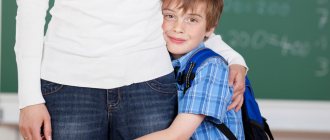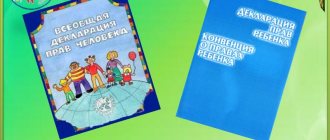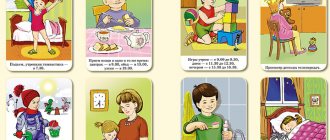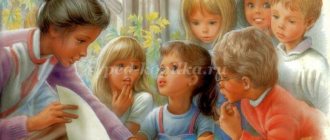The development of the concept of human rights led to the fact that the rights of the child were allocated to a special category. By the beginning of the 21st century, a system for protecting children’s rights at the international level, supported by relevant legal documents, had developed in the world. The fundamental international documents on the protection of children's rights are the Universal Declaration of Human Rights and the Convention on the Rights of the Child. Practical support of the principles enshrined in these documents is the main task of the state in Russia.
We bring to your attention materials for conducting a class hour “Children’s Rights” for students in grades 6-7.
Author: T. V. Ryabtseva
Recommendations for working with the presentation of the class hour “The Rights of the Child” for students in grades 6–7
Lesson option [PDF] [DOCX]
Presentation [PDF] [PPTX]
Student Materials (worksheet) [PDF] [DOCX]
Teacher's materials [PDF] [DOCX]
Quiz [PDF] [DOCX]
Goal: formation of legal consciousness of students, their legal culture.
Tasks:
- develop a general understanding of the rights of the child as enshrined in the Declaration of the Rights of the Child and the Convention on the Rights of the Child;
- promote the development of students’ interest in issues of legal education, their determination of their attitude to law as a public value;
- help schoolchildren formulate their own ideas about modern legal and moral values of society;
- contribute to the development of students’ competencies in protecting the rights, freedoms and legitimate interests of the individual.
The methodological material is advisory in nature; The class teacher, taking into account the characteristics of each class, can vary the tasks, their number, and change the stages of the class hour.
Exercise.
Watch the video. What do you think the phrase “Children have the right to rights” means?
Formulate the topic and main questions of the lesson.
Today we will talk about the rights of the child.
Why do you think this topic is important and relevant?
Every person should know their rights. Minor children are no exception to this rule. From birth, a child is a full-fledged citizen of his country, is endowed with rights, and with age acquires responsibilities.
Every year on November 20, World Children's Rights Day is celebrated.
On November 20, 1959, the UN General Assembly adopted the Declaration of the Rights of the Child , containing 10 essential principles for ensuring the protection and welfare of children.
On November 20, 1989, the UN General Assembly adopted the Convention on the Rights of the Child , an important document regulating the protection of children's rights throughout the world. The Convention is not a list of children’s rights, but a list of the obligations that states have assumed to protect these rights.
Questions:
1. Why do you think there was a need to separate children's rights into a separate category?
2. Why, 30 years after the adoption of the Declaration, was it necessary to adopt another document on the rights of the child - the Convention?
(The Declaration is not binding, it is a recommendation that proclaims the basic principles and program provisions. A convention is an agreement on a special issue that is binding on those states that have joined it. By signing the convention, states declare their obligation to comply with these provisions and in case of non-compliance they are responsible to the international community).
The UN General Assembly (United Nations) recommended that all countries introduce the practice of celebrating World Children's Rights Day as a day of world brotherhood and mutual understanding among children. She invited governments to celebrate this day on any day that each of them considers appropriate.
Task No. 1. (example: all tasks in the appendix)
Read the text and answer the questions.
Questions:
- How is World Children's Day celebrated in different countries?
- What do different nations have in common in the traditions of celebrating this day? Explain your answer.
Task No. 2.
There is a symbol of International Children's Day - a flag recognized today in more than thirty countries around the world.
Consider the image of the flag. Guess what the elements of the flag symbolize.
For reference.
Task No. 3.
Read Article 1 of the Convention on the Rights of the Child. How can one explain this length of childhood?
Read Article 6 of the Convention on the Rights of the Child.
Based on the wording of the article, continue the phrase: “The Convention is not a list of children’s rights, but a list of those obligations ...”
(For example, ... which states have assumed to protect these rights.)
Task No. 4.
Get acquainted with some articles of the Convention on the Rights of the Child. Can you guess what measures are being taken in the states that have acceded to the Convention to guarantee the observance of these rights?
- Inalienable right to life (Article 6).
- The right to a name, citizenship, preservation of one’s individuality (Articles 7, 8).
- The right to freely express one’s opinion (Article 13).
- Access to information (Article 17).
- Children with disabilities have the right to special care (Article 23).
- Right to health care (Article 24).
- The child’s right to education (Article 28).
- The right to rest and leisure (Article 31).
- The right to protection from economic exploitation (Article 32).
Additional material: full text of the Convention on the Rights of the Child.
In what cases can some children's rights be limited? Give examples.
(For example, the right to freedom to seek, receive and impart information may be subject to restrictions in order to respect the rights or reputations of others or to protect national security or public order, or public health or morals.)
Under no circumstances can the right to life be limited!
Task No. 5.
Familiarize yourself with the proposed situations and the content of the articles of the Convention on the Rights of the Child. Match the child's right with the proposed situation. Explain your choice.
The Russian Federation acceded to the Convention on the Rights of the Child in 1990. Children's rights are reflected in the Constitution of the Russian Federation and the Family Code of the Russian Federation; In 1998, the Federal Law “On Basic Guarantees of the Rights of the Child in the Russian Federation (No. 124-FZ) and other legal acts was adopted. One of these laws is Federal Law No. 273-FZ of December 29, 2012 “On Education in the Russian Federation.”
Task No. 6.
Read excerpts from articles of the Law “On Education in the Russian Federation”. What two groups can these articles be divided into? Explain your answer. Draw a conclusion.
Game-exercise “Legal pictograms”
Work in groups.
A pictogram (picture letter) is a symbol that conveys information about an object or idea through illustration.
Task No. 7.
After studying the articles of the Convention on the Rights of the Child, select two that attracted your special attention and “encode” them in the drawing. Ask another group to determine the content of the article you have chosen.
Task No. 8.
Express in one sentence the essence of the Convention on the Rights of the Child.
(For example: as much respect as possible for the child, his rights, care for him, love for him.)
Scenario of the event “I know and defend my rights” (dedicated to “Children’s Day”).
Scenario of the event “I know and defend my rights” (dedicated to “Children’s Day”). The presented event can be held as part of a lesson at a school or multidisciplinary summer camp or children's multidisciplinary summer schools.
The presented event can be held as part of a lesson at a school or multidisciplinary summer camp or children's multidisciplinary summer schools.
The purpose of the event: the formation of the personality of a child of middle and high school age who has knowledge and ideas about the international holiday “Children’s Day” and understands its significance. Formation of a person who knows the basic rights of children, is able to identify their violations and understands what to do and where to turn for help in such cases.
Objectives: to update schoolchildren on the importance of the Children’s Day holiday, to introduce children to their basic rights - or to remind them of them, to teach children to clearly respond to violations of their rights.
Progress of the event
In a classroom or in a small conference room, where there is a projector and tables for classes, the song “Little Country” sounds, and the presenter comes out to the schoolchildren gathered in the hall.
Presenter: June 1 is the beginning of summer, the beginning of the longest school holidays in our country. This day marks International Children's Day, one of the oldest international holidays. The decision to hold it was made in 1925, and in 1950 the first International Children's Day was held on June 1, after which this holiday is celebrated annually.
Childhood is the happiest time in a person’s life. Help us fill in the blanks in a unique essay about what childhood is associated with. On the screen you are presented with a text with missing words - adjectives.
We read together and fill in the gaps with appropriate adjectives.
(Adjectives proposed by students can be any that are appropriate in meaning.)
Childhood is a ... (for example, magical or wonderful) time when a child is surrounded by ... (for example, a caring or loving) family. Parents strive to develop the personality and ... (for example, varied or versatile) abilities of their child, to provide them ... (for example, comprehensive or necessary) support. Childhood is the time to gain ... (for example, useful) knowledge that will be useful in subsequent ... (for example, adult) life.
Host: Such an idealistic picture, unfortunately, does not always correspond to reality. The media and reports on the activities of law enforcement agencies record, bring to the public the facts of violations of children's rights, counteract them and punish the perpetrators. Therefore, Children's Day is not only a fun holiday for the children themselves, it is also a reminder to society of the need to protect the rights of the child, so that all children grow up happy, study, do what they love, and in the future become wonderful parents and citizens of their country.
The presenter invites the audience to participate in a practical lesson, introduces the objectives of this lesson: remember the basic rights of children, learn to identify situations related to their violations, and gain ideas on how to act in cases of threats to the rights of the child.
The presenter offers to look at the list of the most well-known basic rights of the child, reminding those gathered that foreign and Russian legislation recognizes a child as a person who has not reached the age of eighteen (the age of majority).
Presenter: The basic rights of a person, and therefore of a child, are specified in the Constitution of the Russian Federation. In addition to the Constitution, the rights of the child are listed in the Family Code of the Russian Federation:
text on the presentation slide:
Chapter 11 (Articles 54-60) of the Family Code secures the following basic rights for children:
- the right to live and be raised in a family;
- the right to communicate with parents and relatives;
- the right to care and protection;
- the right to a first name, patronymic and last name;
- the right to express one's opinion;
- property rights, including the rights of the owner.
Presenter: The child’s opinion should be taken into account not only in the family, but also by state authorities in cases where the interests of the child are at stake. The consent of a child who has reached the age of 10 is necessary when adopting or establishing guardianship over him, restoring the rights of parents deprived of parental rights, changing his first and last name. From the same age, the child’s opinion should be taken into account when determining his place of residence in the event of parental divorce. The Constitution of the Russian Federation establishes the obligation to obtain basic general education, and labor legislation determines the minimum age for employment from 14 years and establishes the following guarantees for minor workers:
The text on the presentation slide:
Guarantees for minor workers:
- reduced working hours
- longer vacation than for adult workers
- ban on the use of children in heavy, hazardous and night work
- and work that can harm the moral development of a child
The presenter invites the event participants, who have remembered the basic rights of children, to analyze situations in which the rights of minors are violated.
The facilitator distributes worksheets to the class participants. On sheets on one side:
Memo “Dangers from which a child must be protected”
- an attack on the child’s honor and dignity;
- moral and physical violence against a child, neglect of him;
- forcing a child to work that may harm his health and development;
- involving a minor in the use of alcohol, drugs and other psychotropic substances;
- sexual corruption and exploitation of a minor;
- humiliation and inhumane treatment of a child;
- unlawful use of a child’s powers and capabilities, which may cause harm to him or her
On the other side of the handout is a table that looks like this:
| Situations in which the rights of the child are violated | What rights of the child are violated or what threats to the rights of the child exist in these situations? | Recommended actions in the situation |
| Parents in the family punish their children for the slightest offense. At the same time, they insult them, call them stupid, and even raise their hands against them. | ||
| The mother of a minor prohibits his father (who lives separately) from seeing the child and suppresses any attempts by the father to establish contact with him. | ||
| During the adoption procedure, a child who has reached the age of 10 years was not heard and his opinion was not taken into account. | ||
| The primary school teacher regularly noticed signs of beatings on the child’s body, but limited herself to talking with the parents, without reporting the violation of the child’s rights to the guardianship and trusteeship authorities. | ||
| Parents take all the money they earn from a minor working under an employment contract and spend it on their own needs. | ||
| The teacher, noticing that the child was copying answers from a neighbor during a test, insulted the student and hit him on the back of the head. | ||
| The minor's employer engages him to work at night. |
The presenter suggests first reading the memo and then analyzing seven situations in which the rights of minors are violated. In each specific situation, the facilitator asks the participants to determine what dangers the minor is exposed to.
Those gathered together with the presenter discuss which children's rights were violated. After the discussion, a table appears on the screen with the second vertical column filled in.
| Situations in which the rights of the child are violated | What rights of the child are violated or what threats to the rights of the child exist in these situations? | Recommended actions in the situation |
| Parents in the family punish their children for the slightest offense. At the same time, they insult them, call them stupid, and even raise their hands against them. | The right to honor and dignity of the child is violated, the child is subjected to humiliation and inhumane treatment | |
| The mother of a minor prohibits his father (who lives separately) from seeing the child and suppresses any attempts by the father to establish contact with him. | The child’s right to communicate with parents and relatives is violated | |
| During the adoption procedure, a child who has reached the age of 10 years was not heard and his opinion was not taken into account. | The child’s right to express his opinion is violated | |
| The primary school teacher regularly noticed signs of beatings on the child’s body, but limited herself to talking with the parents, without reporting the violation of the child’s rights to the guardianship and trusteeship authorities. | Moral and physical violence is carried out against the child, his right to protection is violated | |
| Parents take all the money they earn from a minor working under an employment contract and spend it on their own needs. | The right of a minor worker to independently dispose of his earnings is violated | |
| The teacher, noticing that the child was copying answers from a neighbor during a test, insulted the student and hit him on the back of the head. | Physical and moral violence is carried out against a child | |
| The minor's employer engages him to work at night. | The employer violates the ban on using children at night |
Host: I propose not to limit ourselves to identifying facts of violation of rights, but to discuss how to act in such situations for everyone who has encountered a violation of the rights of a child.
The presenter warns participants that the actions that both minors themselves can take in case of violation of their rights, and adults who would like to help minors who find themselves in a difficult life situation, are determined by each specific situation. A polite but persistent reminder of your rights and possible adverse consequences for the violator can sometimes prevent a violation of rights. But children in this sense are the most helpless category of the population. However, there are options and there are some general recommendations.
The facilitator invites participants to propose options for action applicable to the problem situations presented in the table.
When participating in the discussion, the facilitator draws attention to the fact that if a violation of the child’s rights was committed in the field of education (in kindergarten, school, college, university), then the parents or legal representatives of the child can try to resolve this issue by contacting the heads of these institutions. Parents defending the interests of their child should contact the school principal directly with a written complaint. If possible, this should be done in person, and you should ask to put a mark indicating receipt of the complaint on your copy. If necessary, the complaint is sent by registered mail with notification. The director, in turn, must give a written response. If it is impossible to resolve the conflict with the participation of the administration of the educational institution, parents should contact government authorities for help. There, in addition to the application, it is advisable to provide evidence of violation of rights. The decision of the authorized body can also be appealed by appealing to the district court at the applicant’s place of residence.
Next, the presenter gives comments on possible options for protecting the rights of children in cases where the rights of children are violated directly by the mother and father, or by one of them. Persons who notice this fact (caregivers, teachers, neighbors of a problem family, parents of the child’s friends) should contact the social security authorities, who, based on the information received, should begin checking the specified family. If this fact is confirmed, representatives of this body may go to court to bring the parents to justice.
If outsiders can complain about the violating family at will, then officials (medical workers, teachers, etc.) who learn about the violation are obliged to do so. And their main goal should be to protect the legitimate interests of children.
The text appears on the screen:
Bodies where you can turn for help:
- guardianship and trusteeship authorities;
- prosecutor's office;
- bodies of the Ministry of Internal Affairs (department for juvenile affairs);
- local police officers
- Commissioner for Children's Rights
The Child Protection Law provides for the possibility of minors directly contacting the relevant authorities, but only if they are over fourteen years old. They can initiate the procedure for deprivation of parental rights (Articles 56 and 70 of the Family Code of the Russian Federation), request the establishment of paternity (Article 62 of the Family Code), and also file a lawsuit to cancel the adoption (Article 142 of the Family Code of the Russian Federation).
After a joint discussion, the table may look like this, and it can be presented to the audience in the next slide of the presentation.
| Situations in which the rights of the child are violated | What rights of the child are violated or what threats to the rights of the child exist in these situations? | Recommended actions in the situation |
| Parents in the family punish their children for the slightest offense. At the same time, they insult them, call them stupid, and even raise their hands against them. | The right to honor and dignity of the child is violated, the child is subjected to humiliation and inhumane treatment. | The child is encouraged to share his problems with others: neighbors, educators, teachers, friends and their parents. Reports from concerned adults about facts of domestic violence to government agencies (police, guardianship and trusteeship authorities, prosecutor's office). It is possible for minors to contact the relevant authorities directly if they are over fourteen years old. |
| The mother of a minor prohibits his father (who lives separately) from seeing the child and suppresses any attempts by the father to establish contact with him. | The child’s right to communicate with parents and relatives is violated. | Reporting the mother’s actions to the guardianship and trusteeship authorities, appealing to the court by the child’s father. |
| During the adoption procedure, a child who has reached the age of 10 years was not heard and his opinion was not taken into account. | The child’s right to express his opinion is violated. | Filing a petition to interview the child (if the procedure has not been completed), appealing the procedure to a higher court (if the adoption procedure has been completed) |
| The primary school teacher regularly noticed signs of beatings on the child’s body, but limited herself to talking with the parents, without reporting the violation of the child’s rights to the guardianship and trusteeship authorities. | Moral and physical violence is carried out against the child, and his right to protection is violated. | Reporting by concerned adults who have become aware of facts of violence against a child in the family to government agencies (police, guardianship authorities, prosecutor's office). |
| Parents take all the money they earn from a minor working under an employment contract and spend it on their own needs. | The right of a minor worker to independently dispose of his earnings is violated. | Reporting the actions of parents to the guardianship and trusteeship authorities. The minor himself appeals to the court with a demand for the return of illegally seized funds. |
| The teacher, noticing that the child was copying answers from a neighbor during a test, insulted the student and hit him on the back of the head. | Physical and moral violence is carried out against the child. | Reporting facts of violence to government authorities (police, guardianship authorities, prosecutor's office). |
| The minor's employer engages him to work at night. | The employer violates the ban on using children at night. | Appeal of the minor employee to the labor inspectorate. |
The presenter asks the audience whether the lesson was useful to them. Thanks the participants for their joint activities and wishes them not to find themselves in situations that threaten their rights. Wishes those gathered to be able to defend their rights.






